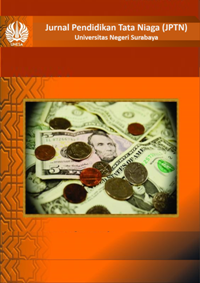IDENTIFIKASI INDUSTRI KREATIF UNTUK MENDUKUNG DESA BANYUURIP DI KABUPATEN GRESIK SEBAGAI DESA WISATA BUNGA
DOI:
https://doi.org/10.26740/jptn.v10n3.p1756-1765Keywords:
desa wisata, identifikasi industri kreatif, pasar bunga, statistik deskriptifAbstract
This study aims to identify the tourism village supporting industry in Banyuurip Village, Kedamean District, Gresik Regency, determine the existing condition of the tourism village support industry in Banyuurip Village, Kedamean District, Gresik Regency, and provide recommendations for the development of supporting industries in Banyuurip Village as a tourist village. The village that has the potential to be improved as a tourist village is Banyuurip Village which is famous for its flower market. Miru Hamlet and Pendem Hamlet located in Banyuurip Village have thousands of types of ornamental plant varieties that can be used as export commodities. The concept of the creative economy is expected to be able to build a village economy where the products produced are highly competitive. The existing creative industries will be seen for their existing conditions, whether there are any that need to be developed and maintained. This research is important considering thatBanyuurip Village has great potential to become a flower tourism destination in Gresik Regency. The research method used is descriptive statistical method and qualitative method. The result of this research is the realization of the Flower Tourism Village. The result of this research is the realization of the Flower Tourism Village. The results show that the type of supporting industry that has the potential to be developed is food and beverage, the majority of which are spread across four hamlets in Banyuurip Village along Bunga Tourism.
Downloads
References
Acmadi,U. F. 2009. Manajemen penyakit berbasis wilayah. Jurnal kesehatan masyarakat universitas Indonesia Vol. 3, No. 4. [online] (Diakses pada tanggal 28 April 2021).
A. Hari Karyono. (1997). Kepariwisataan. Jakarta : Grasindo.
A. J, Mulyadi. (2012). Kepariwisataan dan Perjalanan, Jakarta: Raja Grafindo Persada.
Anthonius Ibori. (2013). Partisipasi Masyarakat Dalam Pelaksanaan Pembangunan Di Desa Tembuni Distrik Tembuni Kabupaten Teluk Bintuni. Jurnal Governance. Vol. 1, No.5.
Gunn, Clare A. (2002). Tourism Planning. New York City : Taylor and Francis.
Kuswanto, Dedy (2012). Statistik Untuk Pemula & Orang Awam. Jakarta: Laskar Aksara.
Pitana, I Gede, I Ketut Surya Diarta. 2009. Pengantar Ilmu Pariwisata. Yogyakarta: C.V Andi Offset.
Pratiwi, Putri, dkk. 2015. Pengaruh Kegiatan Perdagangan Pasar Lawang Terhadap Bangunan Kuno di sekitar Pasar Lawang. Jurnal Planning for Urban Region and Environment. Vol. 4 No. 2 April 2015.
Sastrayuda, Gumelar S., 2010, Konsep Pengembangan Kawasan Desa Wisata, Handout Mata Kuliah Concept Resort and Leisure, Strategi Pengembangan dan Pengelolaan Resort and Leisure.
Sholikhah, Amirotun. (2016). Statistik Deskriptif dalam Penelitian Kualitatif. Jurnal KOMUNIKA, Vol. 10, No. 2
Sugiyono. 2007. Metode Penelitian Kuantitatif Kualitatif dan R&D. Bandung: Alfabeta.
Zakaria, Faris., Suprihardjo, R. D. (20014). Konsep Pengembangan Kawasan Desa Wisata di Desa Bandungan Kecamatan Pakong Kabupaten Pamekasan. Jurnal Teknik POMITS Vol. 3, No.2, (2014) 2337-3520
Dimyati dan Mudjiono. 2006. Belajar dan Pembelajaran. Rineka C
Downloads
Published
How to Cite
Issue
Section
License
Authors who publish with this journal agree to the following terms:
- Authors retain copyright and grant the journal right of first publication with the work simultaneously licensed under a Creative Commons Attribution License that allows others to share the work with an acknowledgement of the work's authorship and initial publication in this journal.
- Authors are able to enter into separate, additional contractual arrangements for the non-exclusive distribution of the journal's published version of the work (e.g., post it to an institutional repository or publish it in a book), with an acknowledgement of its initial publication in this journal.
- Authors are permitted and encouraged to post their work online (e.g., in institutional repositories or on their website) prior to and during the submission process, as it can lead to productive exchanges, as well as earlier and greater citation of published work (See The Effect of Open Access).
Jurnal Pendidikan Tata Niaga (JPTN) is licensed under a Creative Commons Attribution-NonCommercial 4.0 International License.
 Abstract views: 134
,
Abstract views: 134
, PDF Downloads: 246
PDF Downloads: 246



